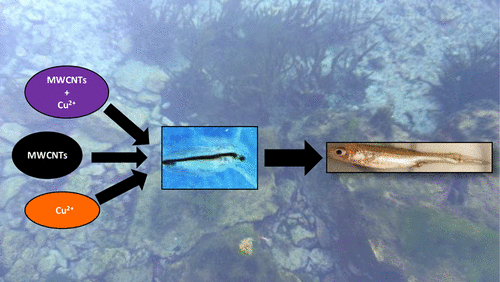当前位置:
X-MOL 学术
›
Environ. Sci. Technol.
›
论文详情
Our official English website, www.x-mol.net, welcomes your
feedback! (Note: you will need to create a separate account there.)
Trophic Transfer and Accumulation of Multiwalled Carbon Nanotubes in the Presence of Copper Ions in Daphnia magna and Fathead Minnow (Pimephales promelas)
Environmental Science & Technology ( IF 10.8 ) Pub Date : 2018-01-05 00:00:00 , DOI: 10.1021/acs.est.7b03522 Amanda M. Cano 1 , Jonathan D. Maul 1 , Mohammad Saed 2 , Fahmida Irin 3 , Smit A. Shah 4 , Micah J. Green 4 , Amanda D. French 1 , David M. Klein 1 , Jordan Crago 1 , Jaclyn E. Cañas-Carrell 1
Environmental Science & Technology ( IF 10.8 ) Pub Date : 2018-01-05 00:00:00 , DOI: 10.1021/acs.est.7b03522 Amanda M. Cano 1 , Jonathan D. Maul 1 , Mohammad Saed 2 , Fahmida Irin 3 , Smit A. Shah 4 , Micah J. Green 4 , Amanda D. French 1 , David M. Klein 1 , Jordan Crago 1 , Jaclyn E. Cañas-Carrell 1
Affiliation

|
The increase in use of nanomaterials such as multiwalled carbon nanotubes (MWCNTs) presents a need to study their interactions with the environment. Trophic transfer was measured between Daphnia magna and Pimephales promelas (fathead minnow, FHM) exposed to MWCNTs with different outer diameter (OD) sizes (MWCNT1 = 8–15 nm OD and MWCNT2 = 20–30 nm OD) in the presence and absence of copper. Pristine FHM were fed D. magna, previously exposed for 3 d to MWCNT1 or MWCNT2 (0.1 mg/L) and copper (0.01 mg/L), for 7 d. D. magna bioaccumulated less MWCNT1 (0.02 μg/g) than MWCNT2 (0.06 μg/g), whereas FHM accumulated more MWCNT1 (0.81 μg/g) than MWCNT2 (0.04 μg/g). In the presence of copper, MWCNT bioaccumulation showed an opposite trend. Mostly MWCNT1 (0.03 μg/g) bioaccumulated in D. magna, however less MWCNT1 (0.21 μg/g) than MWCNT2 (0.32 μg/g) bioaccumulated in FHM. Bioaccumulation factors were higher for MWCNT1s than MWCNT2. However, an opposite trend was observed when copper was added. Plasma metallothionein-2 was measured among treatments; however concentrations were not statistically different from the control. This study demonstrates that trophic transfer of MWCNTs is possible in the aquatic environment and further exploration with mixtures can strengthen the understanding of MWCNT environmental behavior.
中文翻译:

大型蚤(Daphnia magna)和黑头(Fathead Minnow)(Pimephales promelas)中铜离子存在下多壁碳纳米管的营养转移和积累。
诸如多壁碳纳米管(MWCNTs)之类的纳米材料的使用的增加提出了研究其与环境的相互作用的需求。在存在和不存在以下情况下,在暴露于不同外径(OD)尺寸(MWCNT1 = 8-15 nm OD和MWCNT2 = 20-30 nm OD)的MWCNTs中,测定了大型蚤(Daphnia magna)和Pimephales promelas(无头min鱼,FHM)之间的营养转移。铜。将原始的FHM喂食D. magna,事先暴露于MWCNT1或MWCNT2(0.1 mg / L)和铜(0.01 mg / L)3天,持续7 d。玛格纳酒生物积累的MWCNT1(0.02μg/ g)比MWCNT2(0.06μg/ g)少,而FHM积累的MWCNT1(0.81μg/ g)比MWCNT2(0.04μg/ g)多。在铜的存在下,MWCNT的生物蓄积显示出相反的趋势。在大果蝇中生物积累的大部分是MWCNT1(0.03μg/ g),但是与FHM中生物积累的MWCNT2(0.32μg/ g)相比,MWCNT1(0.21μg/ g)少。MWCNT1s的生物蓄积因子高于MWCNT2。然而,当添加铜时,观察到相反的趋势。在治疗之间测量血浆金属硫蛋白-2;然而,浓度与对照组无统计学差异。这项研究表明,MWCNTs在水生环境中可能发生营养转移,并且用混合物进行进一步探索可以加强对MWCNTs环境行为的了解。
更新日期:2018-01-06
中文翻译:

大型蚤(Daphnia magna)和黑头(Fathead Minnow)(Pimephales promelas)中铜离子存在下多壁碳纳米管的营养转移和积累。
诸如多壁碳纳米管(MWCNTs)之类的纳米材料的使用的增加提出了研究其与环境的相互作用的需求。在存在和不存在以下情况下,在暴露于不同外径(OD)尺寸(MWCNT1 = 8-15 nm OD和MWCNT2 = 20-30 nm OD)的MWCNTs中,测定了大型蚤(Daphnia magna)和Pimephales promelas(无头min鱼,FHM)之间的营养转移。铜。将原始的FHM喂食D. magna,事先暴露于MWCNT1或MWCNT2(0.1 mg / L)和铜(0.01 mg / L)3天,持续7 d。玛格纳酒生物积累的MWCNT1(0.02μg/ g)比MWCNT2(0.06μg/ g)少,而FHM积累的MWCNT1(0.81μg/ g)比MWCNT2(0.04μg/ g)多。在铜的存在下,MWCNT的生物蓄积显示出相反的趋势。在大果蝇中生物积累的大部分是MWCNT1(0.03μg/ g),但是与FHM中生物积累的MWCNT2(0.32μg/ g)相比,MWCNT1(0.21μg/ g)少。MWCNT1s的生物蓄积因子高于MWCNT2。然而,当添加铜时,观察到相反的趋势。在治疗之间测量血浆金属硫蛋白-2;然而,浓度与对照组无统计学差异。这项研究表明,MWCNTs在水生环境中可能发生营养转移,并且用混合物进行进一步探索可以加强对MWCNTs环境行为的了解。











































 京公网安备 11010802027423号
京公网安备 11010802027423号